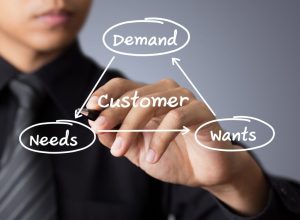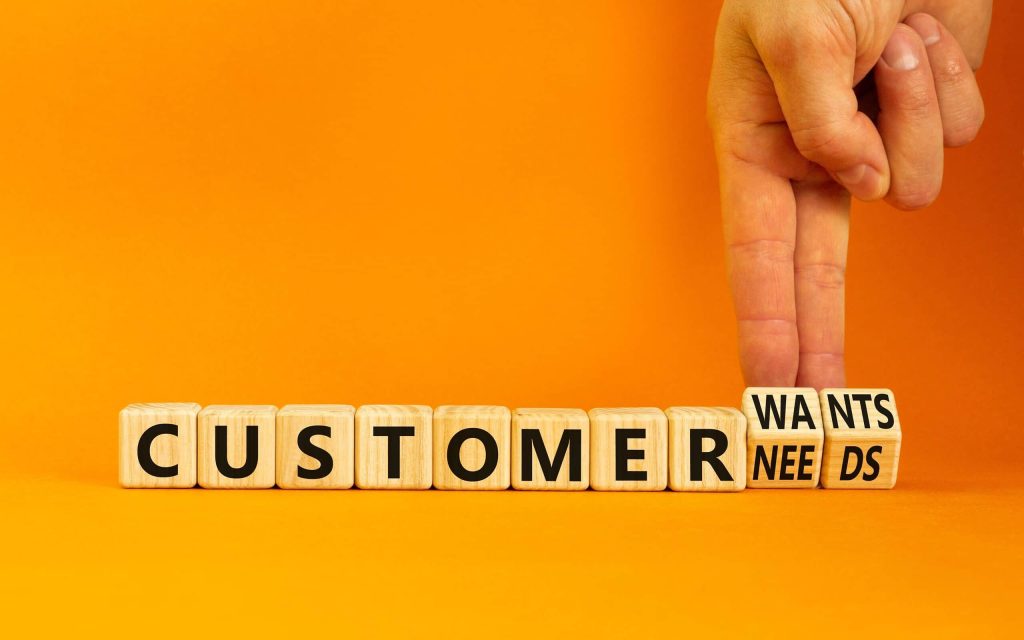The ability to correctly identify and satisfy consumer requirements and expectations is not only advantageous but also essential for survival and success in the fast-paced world of modern commerce. According to a Salesforce study, 76% of consumers believe that businesses should be aware of their wants and expectations. This demonstrates how popular customer-centric company methods are. This comprehensive guide will explore the nature of consumer expectations and wants, clarify how firms may find and use this data, and provide doable tactics for using these insights to increase customer happiness and cultivate loyalty.

Understanding Customer Needs
Fundamentally, the notion of customer demands pertains to the fundamental incentives that prompt consumers to select a certain good or service. Since these demands are what primarily impact people’s purchasing decisions, it is imperative to recognize them. The needs of customers can be broadly classified into two categories:
Functional Needs
The most pressing and obvious requirements are functional ones, which result from particular circumstances or issues that a customer must resolve. For instance, having an umbrella becomes functionally necessary if a sudden downpour starts so you can keep dry. Comparably, the demand for clean eyesight drives the utilitarian need to replace broken glasses.
Psychological Needs
More complex, psychological demands include the psychological or emotional motivations underlying a purchase. These demands frequently represent a desire for fulfillment, self-improvement, or societal approval. For example, a person may purchase fashionable new spectacles to meet psychological needs such as improving look or self-esteem in addition to vision correction.
Defining Customer Expectations
The preconceived notions or standards that customers have when they engage with a brand are known as customer expectations. Their loyalty and level of happiness are highly influenced by these expectations. Customer expectations can be influenced by various factors:
- Previous Personal Experiences: If a customer has enjoyed positive interactions with your brand before, they will likely expect the same level of service again. Conversely, a previous poor experience might lower their expectations.
- Experiences with Competitors: Customer expectations are also influenced by their experiences with your competitors. Good or bad, these experiences set a benchmark against which they will measure your offerings.
- Social Influence: The opinions of friends, family, and online reviews play a crucial role in shaping expectations. Positive reviews can bolster expectations, while negative feedback can diminish them.
- Brand Image: How a brand presents itself in the marketplace, including its advertising, social media presence, and overall communication, also informs customer expectations. A strong, positive brand image can set high expectations.
Identifying Customer Needs and Expectations
To tailor business strategies effectively, companies must first identify what their customers need and expect. This process involves several critical steps:
In-depth Customer Analysis
Understanding your consumers’ demands starts with knowing who they are. It is imperative to do thorough demographic surveys, analyze consumer behavior, and develop segmentation tactics.
Feedback Mechanisms
Utilizing various feedback mechanisms can provide direct insights into what customers think and expect:
- Direct Interviews (Voice of the Customer): Engaging customers directly through interviews can uncover nuanced insights about their needs and purchasing behaviors.
- Focus Groups: By assembling specific groups of people based on set criteria like age or location, businesses can dive deeper into specific areas of interest or concern, gaining valuable insights into customer psychology.
- Surveys: These are versatile tools for gathering data from a broad audience, offering insights into general perceptions, specific preferences, or satisfaction levels related to your products or services.
Behavioral Analytics
You may learn what your consumers value most and what might be causing them to be dissatisfied by analyzing how they engage with your business online and in-store. In this sense, interaction indicators, purchasing trends, and website visits may all be tracked with tools that are quite helpful.
Comprehensive Market Research
Extensive market research may contextualize client expectations by bringing to light industry trends, technical developments, and competitive dynamics.
Implementing Insights to Meet Customer Needs
With a thorough understanding of customer needs and expectations, businesses can implement targeted strategies to enhance their offerings:
Product and Service Optimization
It is important to keep using customer feedback to improve goods and services. Reacting quickly to client requests is essential, whether that means adding new features, fixing flaws, or launching new products.
Enhancing the Customer Experience
Enhancements to the customer experience, website usability, and customer service can greatly increase customer happiness and loyalty.
Personalization Efforts
Engagement and conversion rates can be greatly raised by customizing marketing and communications to each individual customer’s preferences and actions.
Effective Communication
It’s crucial to create message that appeals to your target audience that is clear, consistent, and persuasive. Make sure that every encounter upholds the promises and values of your brand.
Frequently Asked Questions
How can businesses effectively align with customer expectations?
By keeping high standards for both quality and customer service, personalizing customer encounters, and being receptive to feedback, businesses may fit with customer expectations.
Why is understanding customer expectations critical?
Comprehending consumer expectations facilitates the enhancement of customer satisfaction, loyalty, and retention. Additionally, it helps companies to modify their plans in order to better satisfy these demands.
How frequently should feedback be collected?
Feedback should be obtained continuously using a variety of methods, including frequent surveys, social media observation, and face-to-face encounters with customers.
Can small businesses compete with larger companies in meeting customer expectations?
Yes, small firms may compete successfully if they use their agility to swiftly adjust to the needs of their clients, offer individualized services, and cultivate great client relationships.
Businesses may not only satisfy but also surpass consumer expectations by concentrating on comprehending and meeting client wants and expectations. This guarantees long-term success and a competitive edge in the market.
Read Also – US Yields Rise As Powell, The Hawk, Sets A 5% Target



